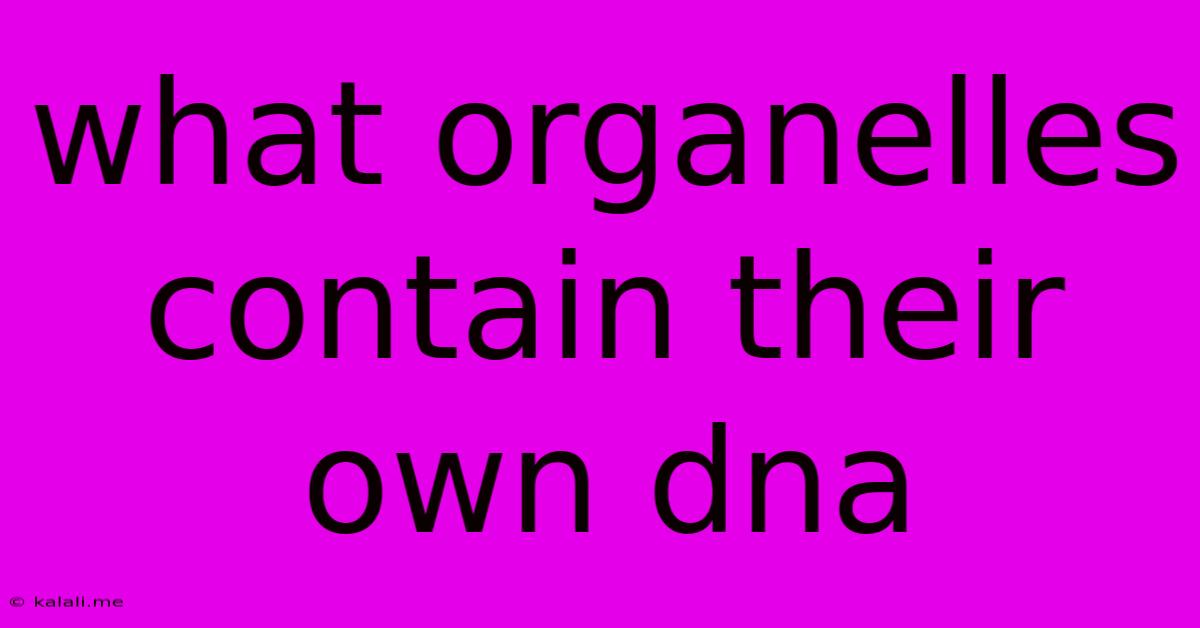What Organelles Contain Their Own Dna
Kalali
Jun 15, 2025 · 3 min read

Table of Contents
What Organelles Contain Their Own DNA? A Deep Dive into Cellular Autonomy
Meta Description: Discover which organelles possess their own DNA and how this impacts cellular function. Explore the evolutionary implications and unique characteristics of these self-sufficient cellular components. Learn about mitochondria, chloroplasts, and their vital roles.
Cells, the fundamental building blocks of life, are incredibly complex structures. Within their confines, various organelles perform specialized tasks, maintaining the cell's overall function and survival. Interestingly, some organelles exhibit a remarkable degree of autonomy, possessing their own DNA separate from the cell's nuclear DNA. This fascinating characteristic has profound implications for cellular biology and evolutionary theory. This article will delve into the organelles that boast their own genetic material, exploring their unique features and significance.
Mitochondria: The Powerhouses with a Past
Arguably the most well-known example, mitochondria are often referred to as the "powerhouses" of the cell because they are responsible for generating most of the cell's supply of adenosine triphosphate (ATP), the primary energy currency. Crucially, mitochondria contain their own circular DNA molecule, known as mitochondrial DNA (mtDNA). This mtDNA encodes a small subset of proteins essential for mitochondrial function, primarily those involved in oxidative phosphorylation, the process by which ATP is generated. The remaining mitochondrial proteins are encoded by nuclear DNA and imported into the mitochondria.
The presence of mtDNA is a strong indicator of the endosymbiotic theory, which proposes that mitochondria were once free-living prokaryotic organisms that were engulfed by eukaryotic cells billions of years ago. This symbiotic relationship proved mutually beneficial, with the host cell providing protection and nutrients, and the mitochondrion providing energy. The retention of their own DNA is a testament to this ancient evolutionary event. Studying mtDNA is also crucial in tracing maternal lineage due to its exclusively maternal inheritance.
Chloroplasts: The Solar-Powered Organelles
Similar to mitochondria, chloroplasts, found in plant cells and algae, also possess their own DNA, known as chloroplast DNA (cpDNA). These organelles are responsible for photosynthesis, the process by which light energy is converted into chemical energy in the form of sugars. Like mtDNA, cpDNA is a circular molecule that encodes a subset of proteins involved in photosynthesis and chloroplast function. The majority of chloroplast proteins are, however, encoded by nuclear genes.
The existence of cpDNA further supports the endosymbiotic theory, suggesting that chloroplasts also originated from free-living photosynthetic prokaryotes that were engulfed by eukaryotic cells. The remarkable similarity between the genetic systems of mitochondria and chloroplasts strengthens this evolutionary hypothesis. Studying cpDNA provides insights into the evolution of photosynthesis and plant diversification.
Other Organelles and Their DNA Content
While mitochondria and chloroplasts are the most prominent examples of organelles with their own DNA, the extent of genetic material within other organelles is a subject of ongoing research. Some research suggests the presence of small, extrachromosomal DNA molecules in other organelles, but their significance and functionality are less well understood.
The Implications of Organellar DNA
The presence of DNA within mitochondria and chloroplasts has significant implications for several areas of study:
- Cellular function: The independent genetic systems of these organelles allow for efficient regulation of their specialized functions.
- Evolutionary biology: Organellar DNA provides crucial evidence supporting the endosymbiotic theory, offering a glimpse into the evolutionary history of eukaryotic cells.
- Medicine and genetics: mtDNA mutations are linked to various human diseases, highlighting the importance of mitochondrial function. Similarly, cpDNA mutations can impact plant growth and development.
- Biotechnology: Understanding organellar DNA and its manipulation offers potential applications in genetic engineering and biotechnology.
In conclusion, the presence of their own DNA within mitochondria and chloroplasts is a remarkable feature of these organelles, reflecting their evolutionary origins and highlighting their crucial roles in cellular function. Continued research in this area promises to unravel further insights into the intricacies of cellular biology and the fascinating story of life's evolution.
Latest Posts
Latest Posts
-
What Is The Sequence Of Blood Flow Through The Kidneys
Jun 16, 2025
-
What Two Oceans Does The Panama Canal Connect
Jun 16, 2025
-
The Study Of Earths Atmosphere Is Known As
Jun 16, 2025
-
Device That Converts Light Energy Into Electrical Energy
Jun 16, 2025
-
Which Of The Following Is An Interjection
Jun 16, 2025
Related Post
Thank you for visiting our website which covers about What Organelles Contain Their Own Dna . We hope the information provided has been useful to you. Feel free to contact us if you have any questions or need further assistance. See you next time and don't miss to bookmark.